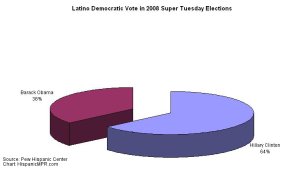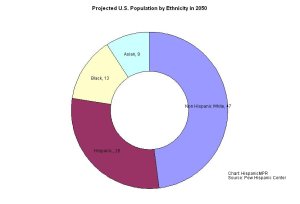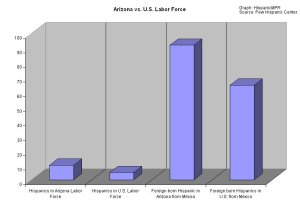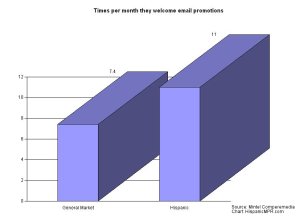Posted by Elena del Valle on March 4, 2008

Latino Democratic Vote in 2008 Super Tuesday Elections – click on image to enlarge
Photo: Pew Hispanic Center
A report based on an analysis of Super Tuesday exit polling data in 16 states about Hispanics from Edison Media Research and Mitofsky International, the firm that conducts exit poll surveys for the National Election Pool, a national consortium of media organizations, indicates Latinos voters could play a deciding role in the selection of a primary Democratic candidate.
Could Latino voters tip the balance in the electoral competition between Hillary Clinton and Barack Obama? Young Latinos seem to be as enthusiastic about Obama as other young people. A string of straight victories for Obama makes the findings of the report ever more important since Clinton’s presidential hopes will rely heavily on the results of the Texas primaries and about one third of Texans are Hispanic.
“Segmentation by Level of Acculturation” audio recording

Presenter Miguel Gomez Winebrenner
Discusses
- Assimilation versus acculturation
- Factors that affect Latino acculturation
- How to know if someone is acculturated
- Number of years necessary for acculturation
- Effects of immigration debate on acculturation
- Three main ways of segmenting Latinos
Click here for details about “Segmentation by Level of Acculturation”
According to the authors of the report, Latinos have already influenced this year’s primaries and caucuses. At the same time Latinos’ share of the Democratic primary vote increased in 12 of the 15 states for which researchers had exit poll data. In the Super Tuesday primaries February 5, 2008 Latinos voted for Clinton (63 percent) almost twice as often as they did for Obama (35 percent).
In California, 30 percent of the voters were Latinos (compared to 16 percent in 2004) and they voted for Clinton by a greater margin than other voters in the state. This year, Hispanic voters have been younger compared to other ethnic groups. More than 20 percent of Hispanic voters on Super Tuesday were 17 to 29 years old, and more than 50 percent of Hispanic voters were younger than 45 years old. Only 33 percent of non Hispanic white voters in the Super Tuesday Democratic primaries were younger than 45.

Mark Hugo Lopez, associate director, Pew Hispanic Center
The report, published by the Pew Hispanic Center and written by Susan Minushkin, deputy director, and Mark Hugo Lopez, associate director, looks at the turnout, demographic characteristics, opinions and voting patterns of Latino voters in relation to the Democratic primaries and caucuses of 2008. Researchers also compared the voting patterns of mainstream, Latino and black voters as well as Latino turnout in 2008 and in 2004.
The Pew researchers aggregated the 16 exit polls and weighted them into a single dataset for each ethnic group voters. There were 1,809 Hispanic, 11,558 white non-Hispanic and 3,120 black non-Hispanic survey respondents. Data from the following 16 states was included: Alabama, Arizona, Arkansas, California, Connecticut, Delaware, Georgia, Illinois, Massachusetts, Missouri, New Jersey, New Mexico, New York, Oklahoma, Tennessee, and Utah.
Prior to working at Pew, Minushkin worked at the Centro de Investigaciones y Docencia Economicas (CIDE) in Mexico City, where she was a professor of international studies and director of an ongoing public and elite survey in Mexico on foreign policy and Mexican attitudes toward international issues. Prior to joining the Pew Hispanic Center, Lopez was research director of the Center for Information and Research on Civic Learning and Engagement (CIRCLE) as well as a research assistant professor at the School of Public Policy at the University of Maryland.
Target Latinos effectively by anticipating changes in the market with
“Hispanic Projections with 2007-08 update” audio recording

Presenter Roger Selbert, Ph.D.
Find out
- About Latino buying power growth in the future
- How Latino market growth compares with other markets in the U.S.
- What drives the rise of Latino economic clout
- Who should target the Latino market
- What is the size of the Hispanic affluent market
- If the luxury Latino market is growing
Stay ahead of your competion with “Hispanic Projections”
Posted by Elena del Valle on February 27, 2008

Scott Painter, CEO, Zag
Photos: Zag, ImpreMedia
Online auto seller Zag, Inc. is teaming up with ImpreMedia, a Spanish language print media company, and Vast.com a vertical search platform for autos, travel, and real estate to create a website targeting Latino consumers in Spanish. Company representatives did not provide details regarding the launch date, investment resources or number of Spanish speaking representatives involved in the partnership and proposed web pages.
The three partners hope to create a new website, impreAutos, accessible from all of the websites of ImpreMedia publications to offer Latino consumers the option of reaching dealers that have Spanish-speaking representatives.
“This is a huge opportunity to radically improve the car-buying process for a large segment of the Hispanic population,” said Scott Painter, chief executive officer, Zag. “Our mission, first and foremost, is to give car buyers a better experience and to use technology to more efficiently connect ready buyers with exceptional dealers. We’re thrilled to partner with ImpreMedia to bring this new approach to the Hispanic market.”
Target Latinos effectively by anticipating changes in the market with
“Hispanic Projections with 2007-08 update” audio recording

Presenter Roger Selbert, Ph.D.
Find out
- About Latino buying power growth in the future
- How Latino market growth compares with other markets in the U.S.
- What drives the rise of Latino economic clout
- Who should target the Latino market
- What is the size of the Hispanic affluent market
- If the luxury Latino market is growing
Stay ahead of your competion with “Hispanic Projections”

Arturo Duran, CEO of ImpreMedia Digital, LLC
“Our goal is to provide a unique car-buying experience for the Hispanic consumer,” said Arturo Duran, chief executive officer of ImpreMedia Digital. “The Zag platform helps facilitate the car buying process for the consumer, providing educational tools and eliminating the fear when buying a car. Our newspapers are trusted by the Hispanic communities they serve, and by partnering with Zag we can make buying a car fun and safe for our readers.”
Zag brings the promise of certified dealers who offer upfront prices, guaranteed in writing not to exceed the market average. The Zag platform enables new and used car buyers willing to make their purchase online to shop for a new vehicle on the web while integrating insurance and financing in the process.
“Like Zag, Vast.com is focused on delivering an exceptional shopping experience for the customer and ready buyers for the dealers. We are thrilled to partner with ImpreMedia and Zag to bring this integrated platform to ImpreMedia’s audience,” said Kevin Laws, CEO, Vast.com.
Vast.com claims an inventory of more than 3.5 million used cars, and promises “a rich set of search and filter tools” to facilitate the car buying process. As part of the agreement with ImpreMedia and Vast.com, Zag dealers hope to gain a sales channel to the Spanish dominant Latino market ImpreMedia reaches via its print publication.
“Best in Class Hispanic Strategies” audio recording


Presenters Carlos Santiago and Derene Allen
-
Find out what makes 25 percent of the top 500 Hispanic market advertisers out perform the remaining companies
-
Discover what questions to ask, steps to take to be a Best in Class company
Click here for information on “Best in Class Hispanic Strategies” audio recording
Posted by Elena del Valle on February 26, 2008

The U.S. Mexican border, U.S. is on the left side of the photo
Photos: Customs and Border Patrol (Gerald L. Nino, James Tourtellotte)
Plans for a 28-mile long virtual fence along the Arizona-Mexico border are moving forward and it looks like Congress may give final approval for the project, according to statements issued by Homeland Security Secretary Michael Chertoff recently.
Boeing Co. is in charge of an initial $20 million contract to establish a high-tech virtual fence along the Mexican border in Arizona. Although it is a public contract, according to a representative of Boeing Co. the company is under contractual obligation to refer all questions on the project to the U.S. Customs and Border Patrol. Representatives from the U.S. Customs and Border Patrol did not respond to repeated requests for project updates.

Customs and Border Patrol staff rely on high tech equipment atop this pole to spot illegal immigrants attempting to cross into the U.S.
The Arizona portion of the high tech fence is the first part of a multibillion-dollar government plan designed to reduce illegal immigration on foot and vehicles along the Canadian and Mexican borders. The project includes 98-foot unmanned towers with cameras and sensors capable of distinguishing people from cattle from up to 10 miles.

Click here to buy Hyperborder
Chicago based Boeing is a leading aerospace company and one of the largest manufacturers of commercial jetliners and military aircraft combined. Boeing also designs and manufactures rotorcraft, electronic and defense systems, missiles, satellites, launch vehicles and advanced information and communication systems.
The U.S. Customs and Border Protection, part of the Department of Homeland Security, is in charge of securing the United States borders and defending the country’s borders against terrorists and their weapons with detection technology, advanced information systems, risk-management, and collaborative ventures with the trade and foreign governments.
Find out what multicultural kids across America think
Listen to Michele Valdovinos, SVP, Phoenix Multicultural in
“Marketing to Multicultural Kids” audio recording

Michele Valdovinos gives a presentation and participates in an extended Q&A discussion about multicultural children based on a Phoenix Multicultural and Nickelodeon study of 1,300 multicultural children in 16 United States markets.
Find out about
• The Phoenix Multicultural Kids Study
• Relationship between children and their context
• Issues relating to family, technology and media, diversity, buying power, relationships in household, self perception, values, acculturation, cultural heritage, frequency of media activity, income and spending, brand preferences, the American Dream
• How many billions of dollars buying power multicultural kids children have
• Children’s spending attitudes, habits by ethnicity
• How much money a year Hispanic kids have available to spend
• Types of products Hispanic kids buy
• Quantitative and qualitative research findings
• Practical applications of information in marketing programs
• Areas of the country where the Latino kids market is booming
Click here for information on “Marketing to Multicultural Kids”
Posted by Elena del Valle on February 19, 2008

U. S. population in 2050 by ethnicity – click on image to enlarge
There should be 438 million souls in America by 2050 and Hispanics may account for 29 percent of the population. According to a recent Pew Hispanic Center report, 82 percent of the growth in the United States from now until 2050 will be the result of immigrant populations and their progeny. While white non Hispanic segments will grow 4 percent, Latino and Asian groups will triple.
By 2050, non Hispanic whites will represent 47 percent of the population, blacks 13 percent and Asian Americans 9 percent. At the same time, one in five American’s may be foreign born compared to one of eight in 2005.
Target Latinos effectively by anticipating changes in the market with
“Hispanic Projections with 2007-08 update” audio recording

Presenter Roger Selbert, Ph.D.
Find out
- About Latino buying power growth in the future
- How Latino market growth compares with other markets in the U.S.
- What drives the rise of Latino economic clout
- Who should target the Latino market
- What is the size of the Hispanic affluent market
- If the luxury Latino market is growing
Stay ahead of your competion with “Hispanic Projections”
The Pew Hispanic Center estimates are slightly higher than the U.S. government’s. The Census Bureau estimates there will be 420 people in the U.S. by 2050. Pew researchers believe immigration will result in 117 million new residents to our country, 67 million from immigrants and 50 million from the American born children and grandchildren of immigrants.
The report was authored by Jeffrey S. Passel, a senior research associate, and D’Vera Cohn, a senior writer, at the Pew Hispanic Center. Prior to working at Pew he was principal research associate at the Urban Institute’s Labor, Human Services and Population Center. Before joining Pew, she was a reporter for 21 years at The Washington Post, where she wrote about race, immigration, and other topics from 1991 to 2006.
The Pew Hispanic Center, an initiative of the Pew Research Center, is a non-partisan, non-advocacy research organization based in Washington, D.C. The Pew Hispanic Center is funded by The Pew Charitable Trusts.
“Segmentation by Level of Acculturation” audio recording

Presenter Miguel Gomez Winebrenner
Discusses
- Assimilation versus acculturation
- Factors that affect Latino acculturation
- How to know if someone is acculturated
- Number of years necessary for acculturation
- Effects of immigration debate on acculturation
- Three main ways of segmenting Latinos
Click here for details about “Segmentation by Level of Acculturation”
Posted by Elena del Valle on February 12, 2008

Mark Potok, director, Intelligence Report of SPLC
Photo: Mark Potok, National Council of La Raza
Is immigration based hate speech aimed at Latinos getting out of hand? Although immigration growth has slowed down in the last 18 months, hate groups have been booming between 2000 and 2007.
Growth estimates for groups with explicitly racial hate messages, due for release this year, are expected to be close to 50 percent, according to a spokesperson from the Southern Poverty Law Center (SPLC). At the same time, data released by the FBI and California officials indicates a 35 percent spike in anti-Latino violence in the United States between 2003 and 2006.
“I do think it will continue. The fact that immigration is slowing down has not reached those groups,” said Mark Potok, director, Intelligence Report of SPLC, an organization that has expressed concern about this issue for the past four years, in relation to the hate group growth in spite of the downward trend in immigration growth.
“Segmentation by Level of Acculturation” audio recording

Presenter Miguel Gomez Winebrenner
Discusses
- Assimilation versus acculturation
- Factors that affect Latino acculturation
- How to know if someone is acculturated
- Number of years necessary for acculturation
- Effects of immigration debate on acculturation
- Three main ways of segmenting Latinos
Click here for details about “Segmentation by Level of Acculturation”
Parallel to the mushrooming of anti-Latino hate groups, there has been a boom of nativists, white supremacist groups who favor U.S. born residents over recent immigrants. Since April 2005, 250 nativist groups have been established in various parts of the country.
SPLC classifies 144 of those groups as Confrontational Nativist Extremists or groups of individuals who exhibit anti-Latino confrontational behavior. Although they tend to be concentrated in Border States, some of the hate groups can also be found in less likely places like Alabama, Georgia, Iowa, and North Dakota.

WeCanStopTheHate website – click on image to enlarge
According to watch dog organizations like SPLC and the National Council of La Raza (NCLR), this surge in violence and vitriolic messages in the United States is worrisome. The Council, in partnership with likeminded organizations, recently launched the Wave of Hope Campaign and a companion website, WeCanStopTheHate.org, to draw attention to the issue. The campaign also urges news media networks and presidential candidates to set aside hateful rhetoric while addressing immigration and Latino issues.
“The immigration issue deserves serious debate and serious solutions,” said Janet Murguía, president and chief executive officer, NCLR. “We cannot have that debate as long as hate has the floor. There’s a bully in the room, and each of these candidates has a choice. They can stand up to the bully or they can cater to him. It is a question of courage or cowardice. To date, we have seen far too little courage.”

Janet Murguía, president and chief executive officer, NCLR
Murguía criticized cable news television for “handing hate a microphone” by hosting representatives from hate and vigilante groups such as Dan Stein of Federation for American Immigration Reform and Jim Gilchrist and Chris Simcox of the Minuteman Project more than 110 times, usually identifying them only as “anti-immigration advocates.”
She also pointed at television figures such as CNN’s Lou Dobbs and Glenn Beck and MSNBC political commentator Pat Buchanan for copying hate speech and providing a forum that demonizes Hispanics. Representatives of CNN declined to respond to email and phone questions about NCLR’s allegation. The Anti-Defamation League, an organization listed in the Allies section of the new website, also declined to respond to questions about the issue and its involvement in the campaign and companion website.
Target Latinos effectively by anticipating changes in the market with
“Hispanic Projections with 2007-08 update” audio recording

Presenter Roger Selbert, Ph.D.
Find out
- About Latino buying power growth in the future
- How Latino market growth compares with other markets in the U.S.
- What drives the rise of Latino economic clout
- Who should target the Latino market
- What is the size of the Hispanic affluent market
- If the luxury Latino market is growing
Stay ahead of your competion with “Hispanic Projections”
Posted by Elena del Valle on February 6, 2008

Click on image to enlarge
Arizona is in the immigration legislation limelight. Beginning last month, it was the first state in the country to pass legislation, the Legal Arizona Workers Act, to punish businesses who knowingly hire illegal immigrants. Although the Act only applies to new hires, some consider the new law aggressive, especially in light of the state’s high percentage of Latinos of Mexican origin, 89 percent. Others worry the new law will result in ethnic and racial discrimination and be difficult to enforce fairly.
“For me it’s very difficult. I feel as if these types of laws encourage racial profiling,” said Regina Romero, City Councilor of Tucson. “I don’t feel comfortable with these types of laws. Are we going to be targeted different? It’s very sad to hear what’s happening in our country. It’s very divisive. We will see after effects of this law.”
Under the new law, which threatens to punish employers who hire undocumented workers by pulling their business license; employers refer to a website to check a worker’s immigration status. Employers who violate the law will receive warnings before any action is taken. To date no companies have been fined.
Some Arizona residents, including elected officials and business sector representatives, say they will enforce the law because it is law although they disagree with it in principal. Critics are upset with the new system including the appeal procedures for workers who fail the verify process. Others plan to challenge the legislation in court.
Target Latinos effectively by anticipating changes in the market with
“Hispanic Projections with 2007-08 update” audio recording

Presenter Roger Selbert, Ph.D.
Find out
- About Latino buying power growth in the future
- How Latino market growth compares with other markets in the U.S.
- What drives the rise of Latino economic clout
- Who should target the Latino market
- What is the size of the Hispanic affluent market
- If the luxury Latino market is growing
Stay ahead of your competion with “Hispanic Projections”
According to the Pew Hispanic Center, in 2005, 65 percent of the illegal immigrant population of the state, almost half a million people, was part of the labor force. In 2005, undocumented foreign workers represented 7 percent of the state’s population and 10 percent of its labor force or double the national average. At the national level undocumented workers account for about 5 percent of the labor force.
In 2006, at the national level, 14.8 percent of the population was Hispanic and in Arizona 29 percent of the population was Hispanic. At the same time, 92 percent of foreign born Hispanics in Arizona were from Mexico compared with only 64.7 percent for the nation as a whole. Taking into account that nearly one third of the state population is Hispanic; and with so many of the state’s Hispanics forming part of the labor force, it’s easy to see how there could be a chilling effect for undocumented immigrants and the employers tempted to hire them.
No one knows how many laborers have lost work as a result of the law or what, if any impact, the legislation will have on the state’s economy. There are rumors that Arizona is loosing some of its residents but no one seems to know for sure. There are concerns that E-Verify, the federal database employers are supposed to refer to when verifying the status of a prospective worker, is inaccurate. Only a fraction of the state’s 150,000 businesses have signed up on the system.
Make your ads resonate with Hispanics
Listen to C&R’s Research Director Liria Barbosa in
“Hispanics’ Perspective on Advertising” audio recording

Liria Barbosa gives a presentation and participates in an extended Q&A discussion about
• Type of ads Latinos prefer
• Latino top media choices
• Percent of Latinos who tried products because of ads
• Percent of Latinos who purchased products because of ads
• What makes an ad “Hispanic”
• If ad language is important for bicultural Latinos
• What to keep in mind when targeting bicultural Latinos with ads
Click here for information on Hispanic Perspectives on Advertising
Posted by Elena del Valle on February 5, 2008

Jerry and Victor Gonzalez, owners of Maria Elena’s Authentic Latino Inc.
Photos: Maria Elena’s Authentic Latino Inc.
In April 2005, California brothers Jerry and Victor Gonzalez established Maria Elena’s Authentic Latino Inc. to offer fruit beverages made from concentrate to Latino consumers in their area. They named the company in honor of their mother, Maria Elena de Gonzalez.
In January of this year, Maria Elena’s Authentic Latino Inc. introduced an organic horchata water soluble drink mix made with rice and cinnamon. The mix is rich in calcium without gluten or Trans fats. With a slightly thicker consistency than water based drinks, it is described by some as tasting “like cinnamon crunch cereal” without the crunch.
Manufactured domestically, the new drink mix will be available at natural food retailers in Southern California in 10-ounce packs for home use for $3.89. It will also be available nationwide in a 1.5 Pound institutional pack for restaurants and coffee houses.
“We consider ourselves Latino Food Artisans,” said Jerry Gonzalez, who worked with Whole Foods Markets for nearly 15 years. “Our mission is to use our deep understanding of natural and organic foods to offer consumers fresh new tastes that put both a nutritious and a delicious twist on traditional Hispanic foods.”

New Horchata mix
Initial efforts will focus on distribution and eventually lead to a promotional program. The new horchata mix may be available in Southern California, Arizona and Nevada as well as online within the near future.
“Our initial efforts with Maria Elena’s Organic Horchata will be a strong push for increased distribution at retail, supported by Account Specific Marketing with key customers. POS, sampling, and cross-promotions with other health-related natural products are all being explored. We are also looking at targeted trade efforts, event marketing and interactive. As wider distribution is achieved we will follow with increased consumer trial-building programs and advertising. Budget is undisclosed,” said Joseph G. Albonetti, president of Latinolandia USA, Maria Elena’s Authentic Latino’s agency of record.
Maria Elena’s Authentic Latino’s primary target audience is second generation acculturated Latinos and customers who like Latino foods. The Hispanic owned and minority certified company is based in Valencia, California where it recently opened a food manufacturing facility. Maria Elena’s Authentic Latino donates a portion of its profits to La Fundacion Juventud Maria Elena’s, its foundation for Hispanic youth.
Make your ads resonate with Hispanics
Listen to C&R’s Research Director Liria Barbosa in
“Hispanics’ Perspective on Advertising” audio recording

Liria Barbosa gives a presentation and participates in an extended Q&A discussion about
• Type of ads Latinos prefer
• Latino top media choices
• Percent of Latinos who tried products because of ads
• Percent of Latinos who purchased products because of ads
• What makes an ad “Hispanic”
• If ad language is important for bicultural Latinos
• What to keep in mind when targeting bicultural Latinos with ads
Click here for information on Hispanic Perspectives on Advertising
Posted by Elena del Valle on February 1, 2008

Click on image to enlarge
Women That Win selected Hispanic Marketing & Public Relations (HispanicMPR.com), Business of the Month for February 2008. As part of the recognition, HispanicMPR is featured on the Women That Win homepage and in the Business of the Month page.
Business of the Month features include a company overview, information about the business’ community involvement and recognitions, when and why the business owner established the business, accomplishments she is most proud of, and advice for women thinking of starting a new business.
Hispanic Marketing and Public Relations Understanding and Targeting America’s Largest Minority book

“A must resource for practitioners/professionals expecting to reach US Hispanics; also valuable for college programs in marketing, public relations and communications. Highly recommended.”
Choice magazine
Click here for information on the Hispanic Marketing & Public Relations books
“I am the founder of this wonderful organization that is helping women, including the many Hispanic women in the U.S., take their careers and lives to the next level. As a woman who began working at the ripe age of 12, I understood very young the power behind a good work ethic,” said Kellie Kuecha, president of Women that Win
Previous Business of the Month companies include The Healing Center, LLC, The Fae Group Graphic Design Company, NuBarter, Judy Martin Speaks.com, Women with Dreams and Zable Fisher Public Relations.
Boca Raton, Florida based Women that Win is dedicated to women’s empowerment. The company offers educational seminars and networking forums to help entrepreneurial women define, develop and achieve their personal and professional goals.
Target Latinos effectively by anticipating changes in the market with
“Hispanic Projections with 2007-08 update” audio recording

Presenter Roger Selbert, Ph.D.
Find out
- About Latino buying power growth in the future
- How Latino market growth compares with other markets in the U.S.
- What drives the rise of Latino economic clout
- Who should target the Latino market
- What is the size of the Hispanic affluent market
- If the luxury Latino market is growing
Stay ahead of your competion with “Hispanic Projections”
Posted by Elena del Valle on January 30, 2008

Actor Eduardo Verástegui and Charles Ogilvie, director of Inflight Entertainment and Partnerships, Virgin America
Photo: Virgin America
Virgin America is offering passengers Spanish-language independent films and television program as part of its Red Inflight Entertainment System. According to promotional materials, the discount airline offers the most foreign language films and television entertainment content on any U.S. domestic airline.
Virgin America launched service on August 8, 2007, and already has had 100,000 passengers. It has agreements with Disney, Fox, Paramount Pictures, NBC Universal Studios, Venevision International, Sony Pictures Entertainment, Terry Steiner International and Warner Brothers to provide major theatrical content at every seat and all its flights through its interactive in flight entertainment system. In addition to English language choices, the company boasts of film, television and audio programming in Cantonese, Mandarin, Japanese, Korean and Spanish.
Spanish-language offerings planned for this year on Virgin America flights to San Francisco, Los Angeles, New York, Washington DC, Las Vegas, San Diego and Seattle include: “Bella,” a film; “Mujeres Infieles” (Unfaithful Women), courtesy of Venevision International; and two programs from Florida based WSBS Mega TV, “El Circulo”and “Xpediente.”
“Best in Class Hispanic Strategies” audio recording


Presenters Carlos Santiago and Derene Allen
-
Find out what makes 25 percent of the top 500 Hispanic market advertisers out perform the remaining companies
-
Discover what questions to ask, steps to take to be a Best in Class company
Click here for information on “Best in Class Hispanic Strategies” audio recording
“As the only California-based airline, we want to our entertainment line-up to be as diverse, sophisticated and smart as our guests,” said Charles Ogilvie, director of Inflight Entertainment & Partnerships, Virgin America. “Finding compelling Spanish-language content is a priority and we’ll continue to search out cutting-edge projects at Sundance and beyond. We’re thrilled that award-winning films like ‘Bella’ with acclaimed actor Eduardo Verastegui can be seen in their native language on Virgin America.”
“Bella” will premier on Virgin America in April 2008. The film recently won the People’s Choice Award at the Toronto Film Festival and the filmmakers were honored with the Smithsonian Latino Center’s prestigious Legacy Award.
“Mujeres Infieles” was directed by Rodrigo Ortuzar and features Maria Jose Prieto. In “El Circulo,” host Ana Remos showcases parties and elegant homes. In “Xpediente,” host Allan Villafana, examines unsolved cases.
“On long-haul flights we find that more than 90 percent of our passengers engage with Red, our in-flight entertainment system. A large percentage of those guests may do something either on-demand (movie, video, music video, or short film) or might listen to or watch a linear channel. In both areas we have multilingual content,” said Abby Lunardini, director of Corporate Communications, Virgin America.
Red offers passengers 25 on-demand films, live TV, audio music entertainment including the ability to compile individual play lists, videogames and meals on-demand. Virgin America is a San Francisco based low-fare carrier. Executives for the airline hope to serve 10 cities within a year of operation, and up to 30 cities within five years.
Make your ads resonate with Hispanics
Listen to C&R’s Research Director Liria Barbosa in
“Hispanics’ Perspective on Advertising” audio recording

Liria Barbosa gives a presentation and participates in an extended Q&A discussion about
• Type of ads Latinos prefer
• Latino top media choices
• Percent of Latinos who tried products because of ads
• Percent of Latinos who purchased products because of ads
• What makes an ad “Hispanic”
• If ad language is important for bicultural Latinos
• What to keep in mind when targeting bicultural Latinos with ads
Click here for information on Hispanic Perspectives on Advertising
Posted by Elena del Valle on January 22, 2008

Click on image to enlarge
Do young Hispanics like to receive promotional offers by email? Chicago-based Mintel staff believe that is true, at least when compared with other groups. According to a survey conducted in English by Mintel Comperemedia, Hispanics welcome email communication from companies they know up to 11 times a month. Non-Hispanic consumers only tolerate such emails up to 7.4 times a month.
Mintel’s findings are based on a statistically representative panel of the U.S. population. Mintel representatives surveyed 1,000 people online in August 2007 in English.
“The Hispanic population is very receptive to email as a means of marketing,” said Carmen Curran, senior email analyst at Mintel Comperemedia. “Hispanics tend to spend more time online than the general population, so receiving information and offers through email makes sense to them. Email fits well into their lives.”
Make your ads resonate with Hispanics
Listen to C&R’s Research Director Liria Barbosa in
“Hispanics’ Perspective on Advertising” audio recording

Liria Barbosa gives a presentation and participates in an extended Q&A discussion about
• Type of ads Latinos prefer
• Latino top media choices
• Percent of Latinos who tried products because of ads
• Percent of Latinos who purchased products because of ads
• What makes an ad “Hispanic”
• If ad language is important for bicultural Latinos
• What to keep in mind when targeting bicultural Latinos with ads
Click here for information on Hispanic Perspectives on Advertising
In a 2006 Online Banking report, Mintel found that Hispanics spent an average of 9.2 hours online at home each week, nearly 10 percent more than the 8.5 hours spent by the general population. Their findings indicate 84 percent used Internet banking services in 2006; only 78 percent of the online population as a whole liked online banking.
Mintel Comperemedia’s recent survey found that younger adults are more open to receiving email communication from companies they know. Adults under 34 who responded to the questions want everything from new offer notifications to account alerts to special promotions via email.
“In 2008, we expect to see more companies using email to market products and services to Hispanic consumers,” said Curran. “With their high Internet usage and stated preference for email communication, email marketing seems to be one of the best alleys into the Hispanic population.”
Mintel Comperemedia is a competitive media monitoring service that analyzes direct mail, email and print advertising trends. Mintel, founded in the United Kingdom 35 years ago, is a supplier of consumer, media and market research. The company, with offices in Chicago, London, Belfast, Sydney and Shanghai, has been studying the United States Hispanic market since 2003.
“Beyond the 30 Second Spot” audio recording
Listen to a 105-minute discussion




Panelists Ivan Cevallos, Hunter Heller, Kitty Kolding and Cynthia Nelson
Our panel of national experts discuss
• Challenges of measuring the impact of the 30-second ad spot
• Innovative tools are useful to reach Latinos
• Changes in marketing to Hispanics
• On which market segment are the changes most relevant
• Effects of technology and time shift on consumer behavior
• Role of multi-screens
• Getting started
• Tips for marketing professionals
Click here to find out about Beyond the 30 Second Spot






































